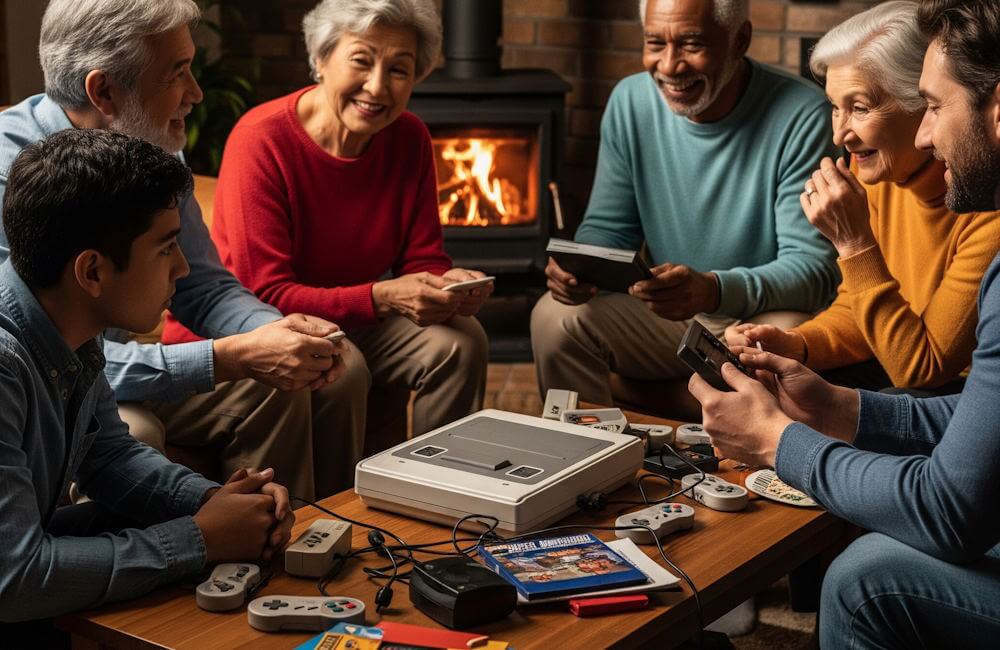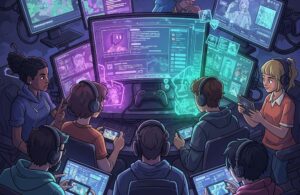Introduction to Nostalgia in Gaming
Nostalgia is a complex, multifaceted emotion that holds significant sway over human behavior and preferences, particularly in the realm of gaming culture. It refers to a sentimental longing for the past, often catalyzed by triggers that evoke cherished memories. Within the context of video games, nostalgia emerges as a potent force, enabling players to reconnect with formative experiences that shaped their identities. This emotional resonance is not merely a fleeting sensation; rather, it can develop into a deep-seated passion, fostering long-lasting fandoms.
The psychological underpinnings of nostalgia suggest that it can enhance mood, promote social connections, and bolster a sense of belonging. In the gaming world, players often recall the first games they played or the platforms through which they discovered these interactive stories. Whether it is the vintage pixels of classic 8-bit games or the engaging narratives of legendary franchises, these experiences contribute to a robust framework of affection that players carry with them throughout their lives. This deep emotional connection can lead to an enduring loyalty to specific game series or developers, elevating them to icons of culture.
Nostalgia acts as a bridge between the past and present, allowing gamers to engage with their beloved titles in fresh, meaningful ways. This may involve remakes, reboots, or nostalgic-themed events that rekindle fond memories. Across generations, the appeal of retro or nostalgic gaming continues to grow, demonstrating that the past remains a fertile ground for creativity and innovation. The unique interplay of nostalgia within gaming culture not only enriches player experiences but also shapes the gaming landscape, reinforcing the connection between gamers and the titles they hold dear.
The Psychology of Nostalgia
Nostalgia is a multifaceted psychological phenomenon that evokes positive emotions and enhances memory recall. For gamers, nostalgia can be a powerful force that fuels their continued passion for long-standing franchises. When individuals encounter elements from their past, particularly through video games, they often experience a profound sense of comfort and security. This is due to nostalgia’s ability to transport players back to a simpler time, where the stresses of adult life were less pronounced. As they engage with familiar characters and settings, players can recapture moments from their youth, allowing them to relive experiences that shaped their identities.
The emotional resonance of nostalgic experiences does not just lie in the gameplay mechanics but also in the context surrounding those memories. Many gamers associate their favorite titles with significant life events, such as childhood friendships, family bonding moments, or personal achievements. This interplay between gaming and life’s milestones creates a complex tapestry of memory where each session can trigger a multitude of emotions. Such evocative recollections can evoke feelings of warmth and happiness, solidifying the bond between the player and the game.
Additionally, research suggests that nostalgia has therapeutic qualities, acting as an emotional balm. When gamers reflect on their cherished titles, the positive emotions elicited can counteract feelings of loneliness or stress. This implies that the act of revisiting beloved games serves not only as entertainment but also as a pathway to emotional well-being. By understanding the mechanisms behind nostalgia, it becomes clear why long-standing fandoms maintain their fervor over time—nostalgia reaffirms connections, evokes profound feelings of happiness, and serves as a reminder of cherished moments shared through gaming experiences.
Iconic Games That Spark Nostalgia
Nostalgia often plays a pivotal role in the gaming community, where players reminisce about their favorite titles that have transcended time. A selection of iconic games has successfully ignited this emotional connection, captivating players not only through their gameplay mechanics but also through engaging storytelling and artistic styles. Games such as “The Legend of Zelda: Ocarina of Time,” released in 1998 for the Nintendo 64, exemplify this phenomenon. The game’s rich narrative combined with memorable characters like Link and Zelda has left an indelible mark on players, leading many to revisit the world of Hyrule time and again.
Another quintessential game is “Final Fantasy VII,” which originally launched in 1997. Its revolutionary approach to storytelling, characterized by deep character development and complex themes, resonates with players even decades later. The visual aesthetics, complemented by an iconic soundtrack composed by Nobuo Uematsu, evoke a sense of nostalgia that is difficult to replicate. This emotional depth has cultivated a dedicated fan base that celebrates both the original release and its modern remake.
Moreover, “Super Mario Bros.” has established itself as a timeless classic that holds a special place in the hearts of gamers across generations. This game not only formed the foundation of the platforming genre but also introduced players to the charismatic world of Mario, Luigi, and their adventures in the Mushroom Kingdom. The simplicity of its design, coupled with innovative gameplay mechanics, has made it a touchstone for many, rekindling fond memories as players navigate its iconic levels.
Overall, these games illustrate how nostalgia can create a lasting bond between players and the virtual worlds they explore. The emotional ties formed through gameplay, storytelling, and artistic elements ensure that these titles continue to be celebrated, affirming their place in gaming history.
Nostalgia and Community Building
Nostalgia plays a pivotal role in forming connections among gamers, serving as a powerful vehicle for community building within the gaming landscape. As players reminisce about their cherished experiences with classic games, these shared memories pave the way for vibrant online communities where fans engage in discussions, share content, and form lasting bonds. Gaming forums, social media groups, and dedicated websites facilitate interactions among individuals who share a deep appreciation for the games that sparked their interest in gaming.
One of the most potent manifestations of nostalgia in gaming communities is the advent of fan conventions, where enthusiasts gather to celebrate their shared love for retro and contemporary gaming experiences. These events often feature panels, workshops, and exhibitions that delve into the history of gaming, highlighting significant titles that have left an indelible mark on the industry. Through these gatherings, gamers can relive their formative experiences, forge new friendships, and even collaborate on creative projects that celebrate their mutual interests.
Online discussions surrounding nostalgic games also contribute significantly to community cohesion. These conversations often focus on gameplay mechanics, character development, and storytelling, sparking debates about the evolution of gaming over the years. Players reflect on how their favorite titles shaped their identities and interests, which in turn fosters a sense of belonging among community members. By sharing their stories, insights, and experiences, individuals not only reinforce their own connections to the games but also create an inclusive environment for newcomers who may be exploring these nostalgic realms for the first time.
Ultimately, nostalgia serves as the cornerstone of community building among gamers. By cultivating shared experiences, online platforms, and conventions play a crucial role in transforming individual memories into collective identities that sustain fandoms over time.
The Role of Remakes and Remasters
In the landscape of video gaming, remakes and remasters have emerged as a crucial element in rekindling nostalgia among fans of classic titles. These projects serve not only to breathe new life into beloved games but also to introduce them to a new generation of players. Utilizing modern technology, developers can enhance graphics, improve gameplay mechanics, and address technical issues, ensuring that these classics can compete with contemporary titles. This revitalization process not only serves commercial purposes but also holds significant emotional value for existing fans who long for their cherished gaming experiences.
The emotional connection that gamers have with older titles plays a pivotal role in the success of remakes and remasters. For many, these games are tied to fond memories—whether it is bonding with friends during multiplayer sessions or the captivating narratives that shaped their gaming identities. By leveraging this nostalgia, developers can create a marketing narrative that resonates deeply with potential buyers. The commercial motivations are evident, as the gaming industry has witnessed substantial financial success from remakes and remasters. Titles like “Final Fantasy VII Remake” and “The Legend of Zelda: Link’s Awakening” have not only garnered praise from longtime fans but have also attracted newcomers, thereby expanding the fanbase.
Moreover, the reception of these projects is often a blend of excitement and scrutiny. Older fans tend to approach remakes with a mix of anticipation and skepticism, weighing their memories against the updated experiences. This juxtaposition can lead to rich discussions within the gaming community, providing opportunities for newer fans to engage with the history of their favorite franchises. Ultimately, remakes and remasters play a pivotal role in sustaining the longevity of gaming fandoms, bridging the gap between past and present, and ensuring that classic titles continue to resonate across generations.
Nostalgia in Game Design and Marketing
Nostalgia has emerged as a powerful tool in the realm of game development and marketing, wherein it serves to forge an emotional connection between gamers and the products they consume. Developers and marketers harness nostalgia by incorporating retro aesthetics, familiar gameplay mechanics, and references to beloved titles from the past, creating a bridge between generations of players. This strategy is particularly effective as it taps into fond memories of earlier gaming experiences, effectively attracting a dedicated fanbase.
Many modern games embrace design elements reminiscent of classic titles, using pixel art graphics and soundtracks that evoke a sense of familiarity. This retro aesthetic not only appeals to the older demographic, who might have grown up with these visuals, but also captivates younger audiences who are often intrigued by vintage styles. Developers like Yacht Club Games with “Shovel Knight” and Team Ninja’s “Ninja Gaiden” revivals exemplify this approach, blending contemporary gameplay with nostalgic designs to resonate with a wider audience.
Moreover, game marketing campaigns frequently utilize nostalgia through carefully curated trailers and promotional materials that highlight these homage elements. By alluding to famed franchises or including Easter eggs that reference prior games, marketers stimulate anticipation and excitement among players. The successful revival of series such as “Final Fantasy” and “The Legend of Zelda” showcases how amplifying nostalgia can reignite interest in established franchises, driving both sales and community engagement.
However, striking the right balance between nostalgia and innovation is crucial. Relying solely on nostalgic references can lead to stagnation, making it vital for developers to integrate modern gameplay mechanics that offer fresh experiences. Ultimately, leveraging nostalgia in game design and marketing can cultivate long-lasting fandoms, significantly impacting how games are perceived and enjoyed in an ever-evolving industry.
Generational Appeal of Nostalgic Games
Nostalgia plays a crucial role in fostering connections among different generations of gamers, providing a common ground that transcends age barriers. As children have grown up surrounded by video games, many now share those experiences with their families, creating lasting memories that often span decades. For numerous individuals, the games they played in their formative years evoke warm sentiments and a strong sense of belonging, which they often seek to share with younger counterparts.
Each generation interacts with nostalgic games in unique ways, remembering the aesthetics, mechanics, and social experiences that defined their gaming culture. For instance, older gamers who grew up during the 1980s and 1990s often reminisce about the simplicity of 8-bit graphics and the thrill of cooperative gameplay. These shared experiences lead to recreation of popular games from the past, often appealing to a sense of simplicity and challenge that modern gaming may lack. Consequently, many classic titles are being revived through remasters or reboots, allowing new players to engage with a piece of gaming history alongside long-time fans.
The intergenerational sharing of games cultivates community bonds and encourages dialogue between age groups. Grandparents, parents, and children can often engage in discussions about their favorite titles, with each group bringing a different perspective to the table. As they play together, they absorb valuable lessons about teamwork, problem-solving, and creativity, further solidifying their familial and communal ties. The emotional connections built through nostalgia contribute significantly to the longevity of gaming fandoms, making it an enduring phenomenon. Nostalgic games continue to unite players of varying ages, enhancing understanding and appreciation among generations while simultaneously promoting and preserving the gaming culture for years to come.
The Dark Side of Nostalgia
Nostalgia often serves as a comforting balm, evoking fond memories and fostering a sense of belonging. However, its darker facets warrant critical examination, particularly within the context of gaming fandoms. This phenomenon can lead aficionados to become overly fixated on past experiences, significantly idealizing them while neglecting the merits of contemporary advancements. The sentiment surrounding nostalgia can create a complex relationship between past enjoyment and current engagement. When individuals long for the “golden days,” they may inadvertently dismiss the value and creativity present in modern gaming narratives and mechanics.
One substantial risk posed by nostalgia is the emergence of ‘nostalgia fatigue,’ a condition wherein repeated exposure to retro-themed content diminishes the joy and excitement it initially inspired. Gamers may find themselves feeling disillusioned when new offerings fail to meet the heightened expectations set by their cherished memories, leading to disappointment and frustration. This discontent can result in an echo chamber where only particular genres, themes, or styles are celebrated, ultimately stifling innovation within the gaming industry. The cycle reinforces a reluctance to embrace new ideas and experiences, causing stagnation in creativity and evolution.
Striking a balance between honoring nostalgic experiences and remaining receptive to innovation can be challenging. While nostalgia provides valuable context and triggers emotional connections, letting it overshadow the potential of new developments can hinder the growth of game fandoms. As gaming evolves, recognizing the importance of diversity in narrative and gameplay is crucial. Acknowledging the past while simultaneously promoting forward-thinking initiatives enables fandoms to thrive in an ever-changing landscape. Balancing appreciation of nostalgia with an openness to fresh concepts is essential for fostering a vibrant gaming culture that values both legacy and innovation.
Conclusion: Embracing Nostalgia for Future Fandoms
Nostalgia plays a pivotal role in shaping the landscape of gaming fandoms, serving as a bridge between past experiences and present engagements. The emotional connections that players forge with games—through their characters, stories, and shared moments—enhance the overall gaming experience, creating a fertile ground for long-lasting fandoms. As we have explored, nostalgia is not a mere relic of the past; it informs current gaming trends and anticipates future developments.
As technology evolves, so too does the way in which games are experienced and remembered. While newer titles may leverage innovative mechanics and graphics, the emotional resonance rooted in nostalgia cannot be easily replicated. The gaming industry is increasingly recognizing this sentiment; remakes and remasters of classic titles are often greeted with enthusiasm, not merely due to nostalgia but also for their ability to bring familiar experiences to new audiences. This dynamic interplay between nostalgia and innovation fosters an inclusive environment where both seasoned gamers and newcomers can coexist and share their passion.
Looking ahead, it is crucial for gamers and developers alike to embrace this nostalgic lens while remaining receptive to emerging narratives, gameplay styles, and technological advancements. Striking a balance between cherishing what once was and exploring new horizons will ensure that gaming fandoms continue to thrive. This ongoing evolution may lead to rich and diverse gaming cultures that honor the past while inviting fresh experiences. Ultimately, by fostering this dual appreciation, we not only celebrate the history of gaming but also lay the groundwork for future generations to forge their own nostalgic memories in the expansive world of gaming.



